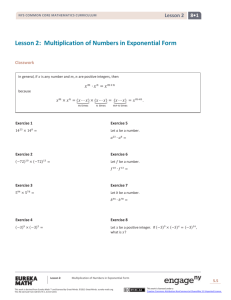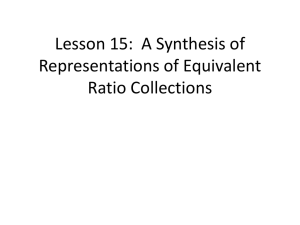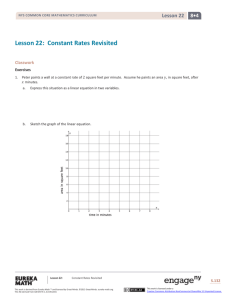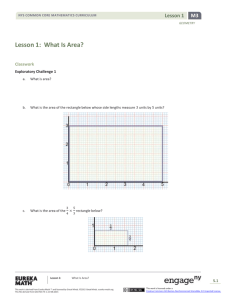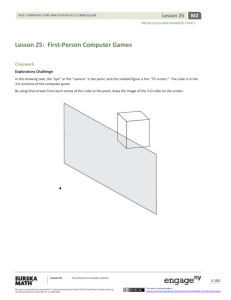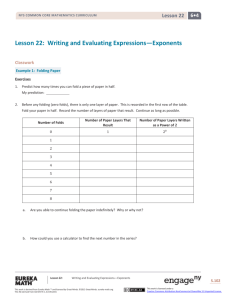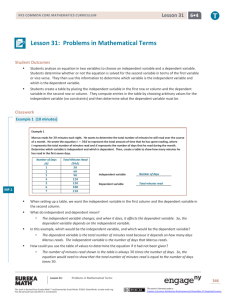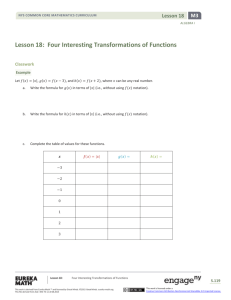Lesson 15 - EngageNY
advertisement
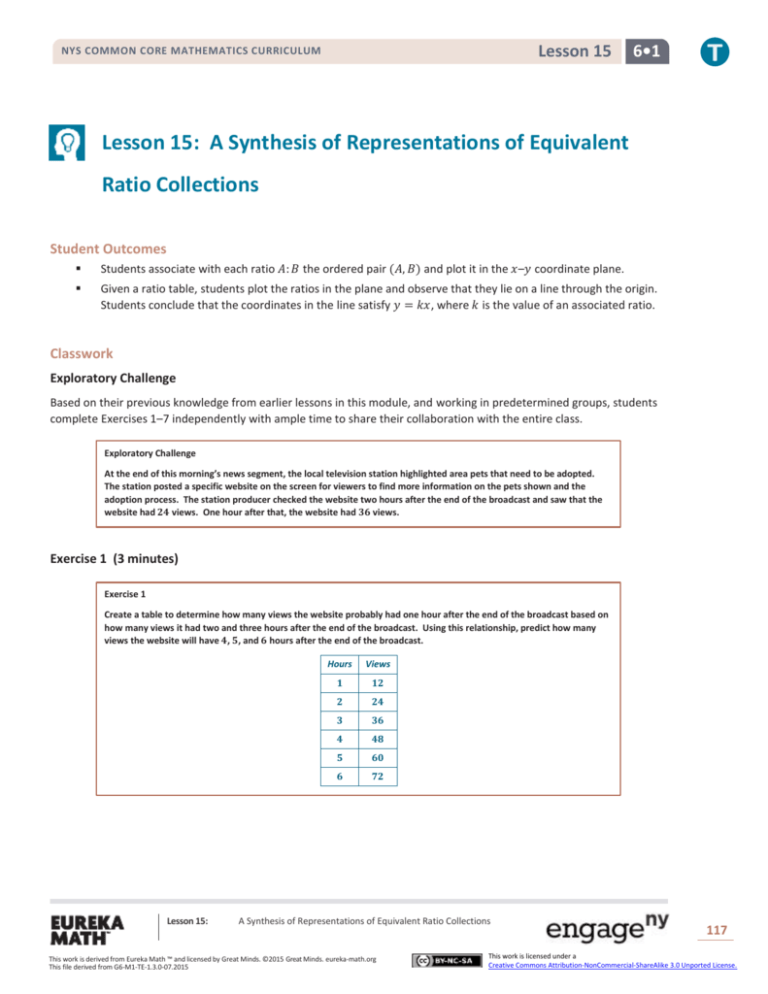
Lesson 15 NYS COMMON CORE MATHEMATICS CURRICULUM 6•1 Lesson 15: A Synthesis of Representations of Equivalent Ratio Collections Student Outcomes Students associate with each ratio 𝐴: 𝐵 the ordered pair (𝐴, 𝐵) and plot it in the 𝑥–𝑦 coordinate plane. Given a ratio table, students plot the ratios in the plane and observe that they lie on a line through the origin. Students conclude that the coordinates in the line satisfy 𝑦 = 𝑘𝑥, where 𝑘 is the value of an associated ratio. Classwork Exploratory Challenge Based on their previous knowledge from earlier lessons in this module, and working in predetermined groups, students complete Exercises 1–7 independently with ample time to share their collaboration with the entire class. Exploratory Challenge At the end of this morning’s news segment, the local television station highlighted area pets that need to be adopted. The station posted a specific website on the screen for viewers to find more information on the pets shown and the adoption process. The station producer checked the website two hours after the end of the broadcast and saw that the website had 𝟐𝟒 views. One hour after that, the website had 𝟑𝟔 views. Exercise 1 (3 minutes) Exercise 1 Create a table to determine how many views the website probably had one hour after the end of the broadcast based on how many views it had two and three hours after the end of the broadcast. Using this relationship, predict how many views the website will have 𝟒, 𝟓, and 𝟔 hours after the end of the broadcast. Lesson 15: Hours Views 𝟏 𝟏𝟐 𝟐 𝟐𝟒 𝟑 𝟑𝟔 𝟒 𝟒𝟖 𝟓 𝟔𝟎 𝟔 𝟕𝟐 A Synthesis of Representations of Equivalent Ratio Collections This work is derived from Eureka Math ™ and licensed by Great Minds. ©2015 Great Minds. eureka-math.org This file derived from G6-M1-TE-1.3.0-07.2015 117 This work is licensed under a Creative Commons Attribution-NonCommercial-ShareAlike 3.0 Unported License. Lesson 15 NYS COMMON CORE MATHEMATICS CURRICULUM 6•1 Exercise 2 (2 minutes) Exercise 2 What is the constant number, 𝒄, that makes these ratios equivalent? 𝟏𝟐 Using an equation, represent the relationship between the number of views, 𝒗, the website received and the number of hours, 𝒉, after this morning's news broadcast. 𝒗 = 𝟏𝟐𝒉 Exercise 3 (2 minutes) Exercise 3 Use the table created in Exercise 1 to identify sets of ordered pairs that can be graphed. (𝟏, 𝟏𝟐), (𝟐, 𝟐𝟒), (𝟑, 𝟑𝟔), (𝟒, 𝟒𝟖), (𝟓, 𝟔𝟎), (𝟔, 𝟕𝟐) Exercise 4 (5 minutes) Exercise 4 Use the ordered pairs you created to depict the relationship between hours and number of views on a coordinate plane. Label your axes and create a title for the graph. Do the points you plotted lie on a line? Number of Views Views per Hour Number of Hours Lesson 15: A Synthesis of Representations of Equivalent Ratio Collections This work is derived from Eureka Math ™ and licensed by Great Minds. ©2015 Great Minds. eureka-math.org This file derived from G6-M1-TE-1.3.0-07.2015 118 This work is licensed under a Creative Commons Attribution-NonCommercial-ShareAlike 3.0 Unported License. Lesson 15 NYS COMMON CORE MATHEMATICS CURRICULUM 6•1 Exercise 5 (8 minutes) Exercise 5 Predict how many views the website will have after twelve hours. Use at least two representations (e.g., tape diagram, table, double number line diagram) to justify your answer. 𝟏𝟐 Hours 𝟏 𝟐 𝟑 𝟒 𝟓 𝟔 𝟕 𝟖 𝟗 𝟏𝟎 𝟏𝟏 𝟏𝟐 Views 𝟏𝟐 𝟐𝟒 𝟑𝟔 𝟒𝟖 𝟔𝟎 𝟕𝟐 𝟖𝟒 𝟗𝟔 𝟏𝟎𝟖 𝟏𝟐𝟎 𝟏𝟑𝟐 𝟏𝟒𝟒 Hours Views 𝟏𝟐 𝟏𝟐 𝟏𝟐 𝟏𝟐 𝟏𝟐 𝟏𝟐 𝟏𝟐 𝟏𝟐 𝟏𝟐 𝟏𝟐 𝟏𝟐 𝟏𝟐 𝟏𝟐 × 𝟏𝟐 = 𝟏𝟒𝟒 Hours 𝟏 𝟐 𝟑 𝟒 𝟓 𝟔 𝟕 𝟖 𝟗 𝟏𝟎 Views 𝟏𝟐 𝟐𝟒 𝟑𝟔 𝟒𝟖 𝟔𝟎 𝟕𝟐 𝟖𝟒 𝟗𝟔 𝟏𝟎𝟖 𝟏𝟐𝟎 𝟏𝟏 𝟏𝟐 𝟏𝟑𝟐 𝟏𝟒𝟒 Exercise 6 (10 minutes) Exercise 6 Also on the news broadcast, a chef from a local Italian restaurant demonstrated how he makes fresh pasta daily for his restaurant. The recipe for his pasta is below: 𝟑 eggs, beaten 𝟏 teaspoon salt 𝟐 cups all-purpose flour 𝟐 tablespoons water 𝟐 tablespoons vegetable oil Determine the ratio of the number of tablespoons of water to the number of eggs. 𝟐: 𝟑 Provided the information in the table below, complete the table to determine ordered pairs. Use the ordered pairs to graph the relationship of the number of tablespoons of water to the number of eggs. Number of Eggs 𝟐 𝟑 (𝟐, 𝟑) 𝟒 𝟔 (𝟒, 𝟔) 𝟔 𝟗 (𝟔, 𝟗) 𝟖 𝟏𝟐 (𝟖, 𝟏𝟐) 𝟏𝟎 𝟏𝟓 (𝟏𝟎, 𝟏𝟓) 𝟏𝟐 𝟏𝟖 (𝟏𝟐, 𝟏𝟖) Number of Eggs Pasta Recipe Tablespoons of Water Tablespoons of Water Lesson 15: A Synthesis of Representations of Equivalent Ratio Collections This work is derived from Eureka Math ™ and licensed by Great Minds. ©2015 Great Minds. eureka-math.org This file derived from G6-M1-TE-1.3.0-07.2015 119 This work is licensed under a Creative Commons Attribution-NonCommercial-ShareAlike 3.0 Unported License. Lesson 15 NYS COMMON CORE MATHEMATICS CURRICULUM 6•1 What would you have to do to the graph in order to find how many eggs would be needed if the recipe was larger and called for 𝟏𝟔 tablespoons of water? Extend the graph. Demonstrate on your graph. How many eggs would be needed if the recipe called for 𝟏𝟔 tablespoons of water? 𝟐𝟒 Exercise 7 (5 minutes) Exercise 7 Determine how many tablespoons of water will be needed if the chef is making a large batch of pasta and the recipe increases to 𝟑𝟔 eggs. Support your reasoning using at least one diagram you find applies best to the situation, and explain why that tool is the best to use. Answers may vary but should include reasoning for each tool. For example, extending the table/double number line diagram because values were already given to find the pattern or using a tape diagram to determine the equivalent ratios. Tablespoons of Water Number of Eggs 𝟐 𝟑 𝟒 𝟔 𝟔 𝟗 𝟖 𝟏𝟐 𝟏𝟎 𝟏𝟓 𝟏𝟐 𝟏𝟖 𝟏𝟒 𝟐𝟏 𝟏𝟔 𝟐𝟒 𝟏𝟖 𝟐𝟕 𝟐𝟎 𝟑𝟎 𝟐𝟐 𝟑𝟑 𝟐𝟒 𝟑𝟔 Water 𝟐 Eggs 𝟑 𝟒 𝟔 Lesson 15: Water 𝟏𝟐 𝟏𝟐 𝟐 × 𝟏𝟐 = 𝟐𝟒 𝟑 × 𝟏𝟐 = 𝟑𝟔 Eggs 𝟑𝟔 𝟔 𝟗 𝟖 𝟏𝟐 𝟏𝟎 𝟏𝟓 𝟏𝟐 𝟏𝟖 𝟏𝟒 𝟐𝟏 𝟏𝟔 𝟐𝟒 𝟏𝟖 𝟐𝟕 𝟐𝟎 𝟑𝟎 𝟐𝟐 𝟐𝟒 𝟑𝟑 𝟑𝟔 A Synthesis of Representations of Equivalent Ratio Collections This work is derived from Eureka Math ™ and licensed by Great Minds. ©2015 Great Minds. eureka-math.org This file derived from G6-M1-TE-1.3.0-07.2015 120 This work is licensed under a Creative Commons Attribution-NonCommercial-ShareAlike 3.0 Unported License. Lesson 15 NYS COMMON CORE MATHEMATICS CURRICULUM 6•1 Closing (5 minutes) Finish any leftover student discussion and presentation. Describe the advantages and disadvantages of using each of the representations of equivalent ratios: table, double number line diagram, equation, and graph. Answers will vary but should include the following: tables allow for organization and prediction of unknown values; double number line diagrams help make visible that there are many, even infinitely many, pairs of numbers in the same ratio; an equation is an efficient way to understand the relationship between the first value and the second value and allows us to simply multiply or divide to find any equivalent ratio; a graph is a visual way to immediately see the relationship between two values. Lesson Summary There are several ways to represent the same collection of equivalent ratios. These include ratio tables, tape diagrams, double number line diagrams, equations, and graphs on coordinate planes. Exit Ticket (5 minutes) Lesson 15: A Synthesis of Representations of Equivalent Ratio Collections This work is derived from Eureka Math ™ and licensed by Great Minds. ©2015 Great Minds. eureka-math.org This file derived from G6-M1-TE-1.3.0-07.2015 121 This work is licensed under a Creative Commons Attribution-NonCommercial-ShareAlike 3.0 Unported License. Lesson 15 NYS COMMON CORE MATHEMATICS CURRICULUM Name ___________________________________________________ 6•1 Date____________________ Lesson 15: A Synthesis of Representations of Equivalent Ratio Collections Exit Ticket Jen and Nikki are making bracelets to sell at the local market. They determined that each bracelet would have eight beads and two charms. Complete the table below to show the ratio of the number of charms to the number of beads. Charms 2 Beads 8 4 6 8 10 ! from the table, and plot the pairs on the graph below. Label the axes of the graph, and provide a Create ordered pairs title. Lesson 15: A Synthesis of Representations of Equivalent Ratio Collections This work is derived from Eureka Math ™ and licensed by Great Minds. ©2015 Great Minds. eureka-math.org This file derived from G6-M1-TE-1.3.0-07.2015 122 This work is licensed under a Creative Commons Attribution-NonCommercial-ShareAlike 3.0 Unported License. Lesson 15 NYS COMMON CORE MATHEMATICS CURRICULUM 6•1 Exit Ticket Sample Solutions Jen and Nikki are making bracelets to sell at the local market. They determined that each bracelet would have eight beads and two charms. Complete the table below to show the ratio of the number of charms to the number of beads. Charms 𝟐 𝟒 𝟔 𝟖 𝟏𝟎 Beads 𝟖 𝟏𝟔 𝟐𝟒 𝟑𝟐 𝟒𝟎 Create ordered pairs from the table, and plot the pairs on the graph below. Label the axes of the graph, and provide a title. Number of Charms to Number of Beads (𝟐, 𝟖) (𝟔, 𝟐𝟒) (𝟖, 𝟑𝟐) (𝟏𝟎, 𝟒𝟎) Number of Beads (𝟒, 𝟏𝟔) Number of Charms Problem Set Sample Solutions 1. 2. The producer of the news station posted an article about the high school’s football championship ceremony on a new website. The website had 𝟓𝟎𝟎 views after four hours. Create a table to show how many views the website would have had after the first, second, and third hours after posting, if the website receives views at the same rate. How many views would the website receive after 𝟓 hours? Hours Views 𝟏 𝟏𝟐𝟓 𝟐 𝟐𝟓𝟎 𝟑 𝟑𝟕𝟓 𝟒 𝟓𝟎𝟎 𝟓 𝟔𝟐𝟓 Write an equation that represents the relationship from Problem 1. Do you see any connections between the equations you wrote and the ratio of the number of views to the number of hours? 𝟏𝟐𝟓𝒉 = 𝒗 Lesson 15: A Synthesis of Representations of Equivalent Ratio Collections This work is derived from Eureka Math ™ and licensed by Great Minds. ©2015 Great Minds. eureka-math.org This file derived from G6-M1-TE-1.3.0-07.2015 123 This work is licensed under a Creative Commons Attribution-NonCommercial-ShareAlike 3.0 Unported License. Lesson 15 NYS COMMON CORE MATHEMATICS CURRICULUM 3. 6•1 Use the table in Problem 1 to make a list of ordered pairs that you could plot on a coordinate plane. (𝟏, 𝟏𝟐𝟓), (𝟐, 𝟐𝟓𝟎), (𝟑, 𝟑𝟕𝟓), (𝟒, 𝟓𝟎𝟎), (𝟓, 𝟔𝟐𝟓) 4. Graph the ordered pairs on a coordinate plane. Label your axes and create a title for the graph. Number of Views Website Hours and Views Number of Hours 5. Use multiple tools to predict how many views the website would have after 𝟏𝟐 hours. Answers may vary but could include all representations from the module. The correct answer is 𝟏, 𝟓𝟎𝟎 views. Lesson 15: A Synthesis of Representations of Equivalent Ratio Collections This work is derived from Eureka Math ™ and licensed by Great Minds. ©2015 Great Minds. eureka-math.org This file derived from G6-M1-TE-1.3.0-07.2015 124 This work is licensed under a Creative Commons Attribution-NonCommercial-ShareAlike 3.0 Unported License. Lesson 15 NYS COMMON CORE MATHEMATICS CURRICULUM 6•1 Graph Reproducible Lesson 15: A Synthesis of Representations of Equivalent Ratio Collections This work is derived from Eureka Math ™ and licensed by Great Minds. ©2015 Great Minds. eureka-math.org This file derived from G6-M1-TE-1.3.0-07.2015 125 This work is licensed under a Creative Commons Attribution-NonCommercial-ShareAlike 3.0 Unported License.

